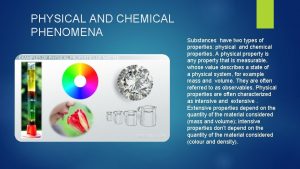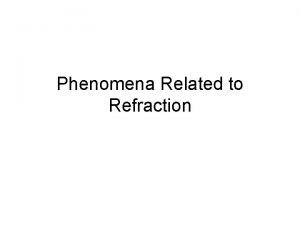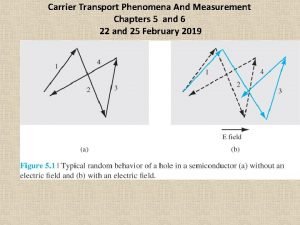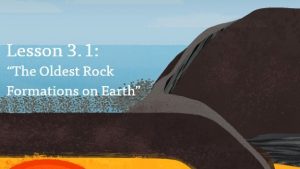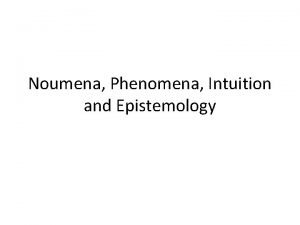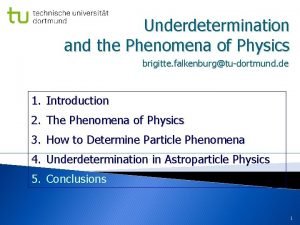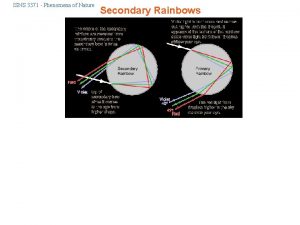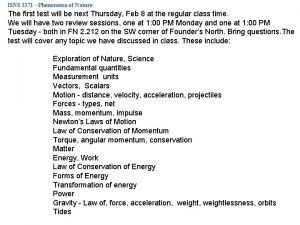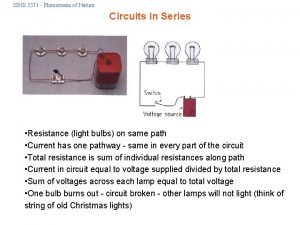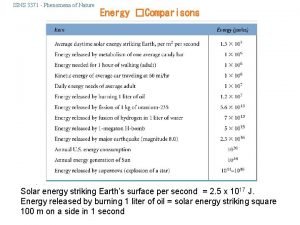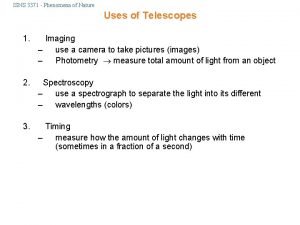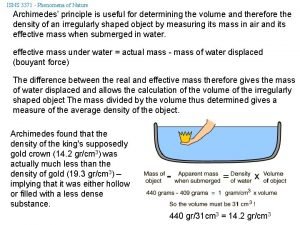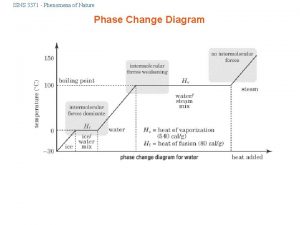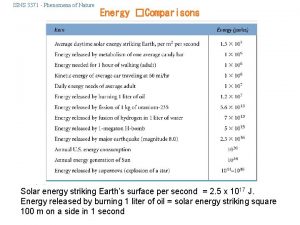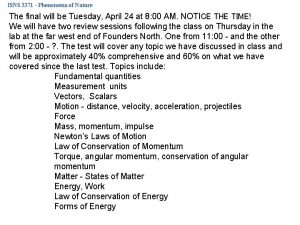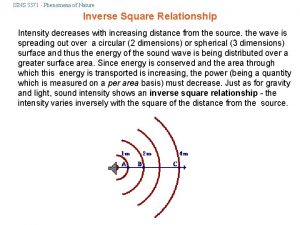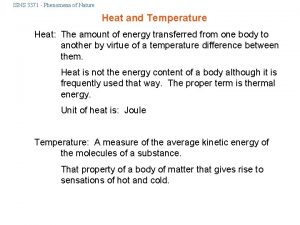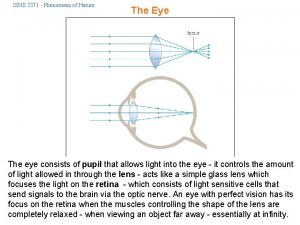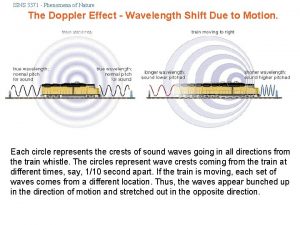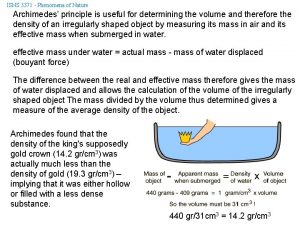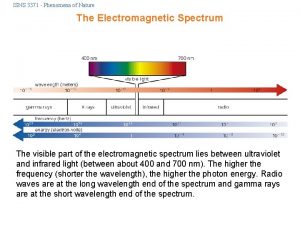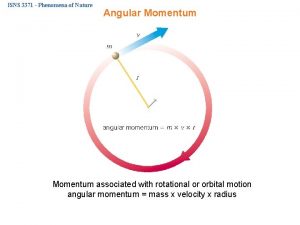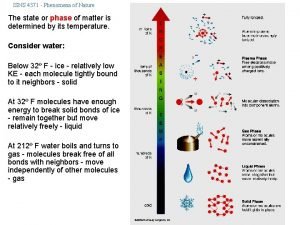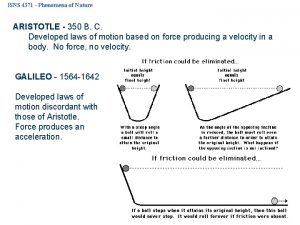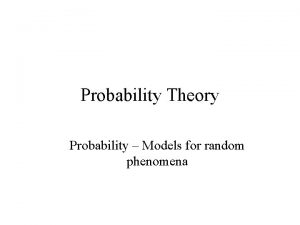ISNS 3371 Phenomena of Nature The second test






















- Slides: 22

ISNS 3371 - Phenomena of Nature The second test will be next Thursday, March 15 at the regular class time. We will have two review sessions, one at 1: 00 PM today (Tuesday) and one at 1: 00 PM tomorrow (Wednesday), both in FN 2. 212 on the SW corner of Founder’s North. The test will cover any topic we have discussed in class. These include: Heat, Temperature Transfer of heat - Conduction, Convection Change of state of matter Gases - gas laws: Boyle, Charles, Guy Lusac, General Laws of Thermodynamics Archimedes’ Principle Bernoulli Effect Waves, Properties of Waves Standing Waves Sound Waves Resonance, Interference Pitch vs. Frequency, Loudness vs. Intensity

ISNS 3371 - Phenomena of Nature Standing Wave vs Traveling Wave Traveling wave - a type of wave pattern which is seen traveling through a medium - crests are seen to propagate through the medium Standing wave - a wave reflected in such a way that it does not propagate. node: point where particles are at rest. antinode: point where particles execute maximum periodic motion, (maximum amplitude). Standing wave modes arise from the combination of reflection and interference.

ISNS 3371 - Phenomena of Nature Interference Two traveling waves which exist in the same medium will interfere with each other. If amplitudes add - constructive interference. If they are "out of phase" and subtract - destructive interference Constructive interference is the combined result of two waves that are exactly in phase. In other words, both of the waves are operating at the exact same frequency and both of them crest at the exact same moment. Destructive interference is the combined result of two waves that are out of phase. In other words, When the crest of one wave occurs at the same time as the trough of another wave.

ISNS 3371 - Phenomena of Nature Interference Constructive - waves add in phase, producing larger peaks than any wave alone. Destructive - waves add out of phase, producing smaller peaks than a single wave alone.

ISNS 3371 - Phenomena of Nature Interference of Waves Dark lines are crests and light lines are troughs - interference creates a pattern. Constructive interference occurs at A and B - crests are twice as high Destructive interference occurs at C, D, E, and F - the waves cancel out

ISNS 3371 - Phenomena of Nature Reflection The string appears to vibrate in segments or regions and the fact that these vibrations are made up of traveling waves is not apparent - hence the term "standing wave".

ISNS 3371 - Phenomena of Nature Producing a Standing Wave When a wave of the proper frequency is produced on a string, a node occurs at the end of the string and the interference of the incident wave and the reflected wave occur in such a manner that there are specific points along the medium which appear to be standing still.

ISNS 3371 - Phenomena of Nature Sound Waves • Longitudinal or compressional wave • Vibrating source pushes air molecules adjacent to it closer together compresses them. This motion is handed on from molecule to molecule. Thus is generated a compressional wave that propagates through the air. Each compression is followed by a rarefaction, a region of lesser density. • The wave travels through the air but each molecule only moves forth and back in its local position.

ISNS 3371 - Phenomena of Nature Propagation of a compression along the particles of a medium. Propagation of a rarefaction along the particles of a medium.

ISNS 3371 - Phenomena of Nature Tuning Fork A vibrating tuning fork - capable of creating a longitudinal sound wave. As the tines of the fork vibrate back and forth, they push on neighboring air particles. The forward motion of a tine pushes air molecules horizontally to the right and the backward retraction of the tine creates a low pressure area allowing the air particles to move back to the left. Because of the longitudinal motion of the air particles, there are regions in the air where the air particles are compressed together and other regions where the air particles are spread apart - compressions and rarefactions. The compressions are regions of high air pressure while the rarefactions are regions of low air pressure.

ISNS 3371 - Phenomena of Nature Sound - A Pressure Wave Sound wave - consists of a repeating pattern of high pressure and low pressure regions moving through a medium. A plot of pressure vs. time appears as a sine curve. The crests of the sine curve correspond to compressions; the troughs correspond to rarefactions; and the "zero point" corresponds to the pressure which the air would have if there were no disturbance moving through it.

ISNS 3371 - Phenomena of Nature The Ear When a pressure wave reaches the ear, a series of high and low pressure regions impinge upon the eardrum. The arrival of a compression or high pressure region pushes the eardrum inward; the arrival of a low pressure regions pulls the eardrum outward. The continuous arrival of high and low pressure regions sets the eardrum into vibrational motion. The eardrum is attached to the bones of the middle ear - the hammer, anvil, and stirrup. As these bones begin vibrating, the sound signal is transformed from a pressure wave traveling through air to the mechanical vibrations of the bone structure of the middle ear. These vibrations are then transmitted to the fluid of the inner ear where they are converted to electrical nerve impulses which are sent to the brain.

ISNS 3371 - Phenomena of Nature Loudspeakers If you put your finger gently on a loudspeaker you will feel it vibrate - if it is playing a low note loudly you can see it moving. When it moves forwards, it compresses the air next to it, which raises its pressure. Some of this air flows outwards, compressing the next layer of air. The disturbance in the air spreads out as a travelling sound wave. Ultimately this sound wave causes a very tiny vibration in your eardrum.

ISNS 3371 - Phenomena of Nature “In Space, No One Can Hear You Scream” Without a medium such as air or water, there is no sound.

ISNS 3371 - Phenomena of Nature Speed of sound • air: 1100 ft/sec (750 mph) • water: 4700 ft/sec • Steel: 15000 ft/sec • Air is a non-dispersive medium All sound frequencies travel at the same speed. • Speed is a function of temperature. It increases 1. 1 ft/sec for each degree F rise in air temperature.

ISNS 3371 - Phenomena of Nature Properties of Sound Waves Pitch: Highness or lowness of sound Related to frequency of sound wave. Intensity: Average rate at which acoustic energy passes a point. Related to amplitude of sound wave. Loudness: Magnitude of sensation of sound as judged by an individual. Subjective aspect of hearing process.

ISNS 3371 - Phenomena of Nature Frequency of wave • • Frequency of sound wave is related to pitch of sound Low frequency - low pitch High frequency - high pitch Range of audible frequencies 20 hertz to ~18, 000 hertz (1 hertz = 1 cycle per second)

ISNS 3371 - Phenomena of Nature Frequency of notes on staff (C): 66, 132, 264, 528, 1056 (hertz) Each succeeding note is 1 octave higher and has twice the frequency Standard frequency: A = 440 hertz.

ISNS 3371 - Phenomena of Nature Certain sound waves when played (and heard) simultaneously will produce a particularly pleasant sensation when heard, are said to be consonant. Such sound waves form the basis of intervals in music. Interval Frequency Ratio Examples Octave 2: 1 512 Hz and 256 Hz Third 5: 4 320 Hz and 256 Hz Fourth 4: 3 342 Hz and 256 Hz Fifth 3: 2 384 Hz and 256 Hz Many people, especially those who have been musically trained, are capable of detecting a difference in frequency between two separate sounds which is as little as 2 Hz.

ISNS 3371 - Phenomena of Nature Intensity and loudness Physical vs psychological characteristic of sound - no direct relationship. Intensity related to amplitude of sound wave, or to the pressure variation in the sound wave. Loudness depends on intensity, frequency and sensitivity of ear. Intensity is proportional to the amount of sound energy that is flowing past a given point. The greater the amplitude of vibrations of the particles of the medium, the greater the rate at which energy is transported through it, and the more intense that the sound wave is. Intensity is the energy/time/area; and since the energy/time ratio is equivalent to the quantity power, intensity is simply the power/area. Typical units for expressing the intensity of a sound wave are Watts/meter 2.

ISNS 3371 - Phenomena of Nature Sound intensity Sound pressure: Minimum audible: one billionth of atmospheric pressure corresponds to an intensity of 1 X 10 -12 W/m 2. Threshold of pain: one thousandth of atmospheric pressure - 1 X 101 W/m 2 Range of audible pressure changes is 1 million - 16 orders of magnitude in intensity Scale to measure these is called decibel scale (db). Since the range of intensities which the human ear can detect is so large, the scale which is frequently used by physicists to measure intensity is a scale based on multiples of 10 - a logarithmic scale. The scale for measuring intensity is the decibel scale. The threshold of hearing is assigned a sound level of 0 decibels (abbreviated 0 d. B). A sound which is 10 times more intense (1 X 10 -11 W/m 2) is assigned a sound level of 10 d. B, a sound 100 times more intense (1 X 10 -10 W/m 2) is assigned a sound level of 20 db, etc…

ISNS 3371 - Phenomena of Nature Source Intensity Level # Times Greater Than TOH Threshold of Hearing (TOH) 1 X 10 -12 W/m 2 0 d. B 1 Rustling Leaves 1 X 10 -11 W/m 2 10 d. B 101 Whisper 1 X 10 -10 W/m 2 20 d. B 102 Normal Conversation 1 X 10 -6 W/m 2 60 d. B 106 Busy Street Traffic 1 X 10 -5 W/m 2 70 d. B 107 Vacuum Cleaner 1 X 10 -4 W/m 2 80 d. B 108 Large Orchestra 6. 3 X 10 -3 W/m 2 98 d. B 109. 8 Walkman at Maximum Level 1 X 10 -2 W/m 2 100 d. B 1010 Front Rows of Rock Concert 1 X 10 -1 W/m 2 110 d. B 1011 Threshold of Pain 1 X 101 W/m 2 130 d. B 1013 Military Jet Takeoff 1 X 102 W/m 2 140 d. B 1014 Instant Perforation of Eardrum 1 X 104 W/m 2 160 d. B 1016
 Police academy nes
Police academy nes 27 miles per gallon into kilometers per liter
27 miles per gallon into kilometers per liter Phenomena yksikkö
Phenomena yksikkö Some natural phenomena ppt
Some natural phenomena ppt Physical and chemical phenomena
Physical and chemical phenomena Refraction phenomena
Refraction phenomena Observable phenomenon
Observable phenomenon Objective phenomena
Objective phenomena Reference phenomena in nlp
Reference phenomena in nlp Reference phenomena in nlp
Reference phenomena in nlp Colloid examples
Colloid examples Gravitation is a natural phenomenon where
Gravitation is a natural phenomenon where Carrier transport phenomena
Carrier transport phenomena Anchor phenomena
Anchor phenomena Observable phenomena
Observable phenomena Importance of interfacial phenomena in pharmacy
Importance of interfacial phenomena in pharmacy Reoulox phenomena
Reoulox phenomena Global climate phenomena
Global climate phenomena Random phenomena
Random phenomena Noumena and phenomena
Noumena and phenomena Examples of sinusoidal functions in real life
Examples of sinusoidal functions in real life Brigitte falkenburg
Brigitte falkenburg Slidetodoc
Slidetodoc




